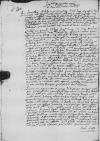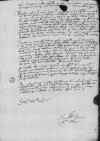Congessi in ⌊⌋ meis ad serenissimam ⌊maiestatem regiam⌋ omnia, quae a ⌊Caesaraugusta⌋, unde scripsi novissimas, hucusque se obtulerunt. Ex his Maiestas Vestra Serenissima omnia abunde intelleget, in quibus adhuc versemur angustiis et quae molimina adversus ⌊Statum Barensem⌋ hic fabricantur post victoriam, quam nuper caesariani contra ⌊Gallos⌋ habuerunt, quae ne succedant, toti<s> viribus reniti oportet.
Quanto me gaudio cum ⌊⌋ Serenissimae Maiestatis Vestrae datis ⌊Radomiae⌋ 1528-03-02⌊secunda Martii1528-03-02⌋ venerabilis dominus ⌊Ioannes Levicius⌋, cantor Plocensis, affecerit, neque scribi neque dici potest. Habeoque igitur Maiestati Vestrae Serenissimae, quas tenuitas mea potest, immortales gratias, quod me tandem hidden by binding⌈[em]em hidden by binding⌉ ex hoc e ms. a(!)
⌈ee ms. a(!)
⌉rgastulo in quinto anno revocare dignata sit. Studeboque promereri eam erga me gratiam Maiestatis Vestrae Serenissimae, quamdiu in me est halitus. Nullum beneficium, nullus episcopatus, nihil denique, quod a Maiestate Vestra Serenissima praestari potest, umquam mihi gratius futurum est, quam haec revocatio, unde dedi omnem operam, ut quantocius a ⌊maiestate caesarea⌋ absolverer. Quod licet iam factum sit, valeque dictum et manus data, tamen ultimum responsum de adoha et de officialibus Serenissimae Maiestatis Vestrae, quorum aliqui in hoc bello ad hostes feruntur defecisse, ne in crimen laesae maiestatis cum ⌊Statu Barensi⌋ incideremus, me adhuc, licet valde invitum, retinuerunt. Nollem enim, quod tantae expensae Maiestatis Vestrae Serenissimae et tot mei labores, quos hic a 4 annis et duobus mensibus fidelissime impendi, per nescio quas sycophantias almitterentur hidden by binding⌈[ntur]ntur hidden by binding⌉. Qua de re, ut scripsi in ⌊⌋ ad ⌊maiestatem regiam⌋, adhuc hic, quod revera mihi durissimum est, cum domino ⌊Levicio⌋ aliquamdiu manebo, ut videam, quid sibi ista nova molimina velint, quibus me, quoad eius a me fieri potest, opponam nihilque praetermittam, ut feci hucusque semper, quod fidelem servum concernit.
Timeo, ne novus iste vicerex ⌊princeps de Oranges⌋ vestigia ⌊praedecessoris sui Mineval⌋ sequatur, inductus fortassis per quosdam, qui Maiestati Vestrae Serenissimae et statui Barensi adhuc malevolunt, habetque ad hoc in hac curia magistrum satis improbum, ⌊Ioannem Lalmant⌋, de quo iam scripsi toties. ⌊Qui⌋ mihi pridie nomine ⌊caesaris⌋ respondit de adoha, ut est in litteris ad maiestatem <regiam>, ad quas me refero, vereorque, ne suboleat 60 milia duc(atorum), quos illustrissima olim ⌊mater⌋ Maiestatis Vestrae in ista adoha retinuit, et quos ⌊Sigismundus Loffredus⌋ voluit, ut dominus ⌊magnus cancellarius⌋ a ⌊caesare⌋ peteret, ut sic cum ista summa et defectione ⌊Scipionis de Summa⌋ novas Maiestati Vestrae super ⌊Statu Barensi⌋ ingererent difficultates. Cum haec apud me perpendi, ne istiusmodi technae rebus Maiestatis Vestrae Serenissimae incommodarent, non potui pro eo affectu, quem habeo ad servitia Maiestatis Vestrae Serenissimae, mihi temperare, quin adhuc hic maneam, quo et  BCz, 242, p. 201 dominus ⌊Levicius⌋ in rebus agendis in hac curia fieret instructior, et negotia Maiestatis Vestrae securiora a stain⌈[a stain, possibly post⌈aa stain, possibly post⌉]a stain⌉ me relinquerentur.
BCz, 242, p. 201 dominus ⌊Levicius⌋ in rebus agendis in hac curia fieret instructior, et negotia Maiestatis Vestrae securiora a stain⌈[a stain, possibly post⌈aa stain, possibly post⌉]a stain⌉ me relinquerentur.
Redire ad Maiestatem Vestram Serenissimam ex tam gravibus expensis et meos tum demum quantum invisere desidero, testis est mihi Deus, qui et cor, et lacrimas meas in eo vidit saepius, sed cum hanc necessitatem, quae rebus Maiestatis Vestrae incumbit, apud me reputo, omne redeundi desiderium, quantum possim, ad tempus reicio speroque, quod in paucis diebus opera domini ⌊cancellarii⌋ et domini ⌊comitis de Nassau⌋, quos semper rebus Maiestatis Vestrae Serenissimae repperi propensos, sycophantias istas retundam et cum aliqua gratia a ⌊caesare⌋ in adoha et sine detrimento rerum Maiestatis Vestrae ratione defectionis ⌊Scipionis de Summa⌋ brevi ad Maiestatem Vestram Serenissimam revertar.
Scripsi in ⌊⌋ ex ⌊Caesaraugusta⌋, quomodo provisio ex ⌊Bario⌋, qua hic vixi, ob haec bella cessaverit, cum ⌊Welzeri⌋ neminem suorum ibidem habeant, effeci tamen cum eis, quod ad meam fidem ea mihi dant et daturi sunt, quo et servitium Maiestatis Vestrae Serenissimae, quamdiu adhuc hic ero, sustentare et reditum meum maturare possim. Idem feci pro domino ⌊Ioanne Levicio⌋, quousque Maiestas Vestra aliter provideat ipsi. Certe 25 ducatos per mensem neque pro simplici sollicitatore hic vivere poterit. De quo, Deo bene favente, brevi coram latius.
A 1528-03-02⌊secunda die Martii1528-03-02⌋, cuius sunt novissimae ⌊⌋ Maiestatis Vestrae Serenissimae, nihil huc scripsit Maiestas Vestra, cum tamen instructio Maiestatis Vestrae in his rebus, quae nunc prae manibus sunt, plus sit necessaria, quam prius umquam, spero tamen, quod paulo post litteras hic Maiestatis Vestrae Serenissimae simus habituri.
Quod reliquum est, cum alia omnia sint in litteris ad ⌊maiestatem regiam⌋, me suppliciter Maiestati Vestrae Serenissimae commendo et rogo, fidelis et durae meae servitutis aliquando rationem habeat.
 BCz, 242, p. 201 dominus
BCz, 242, p. 201 dominus 
